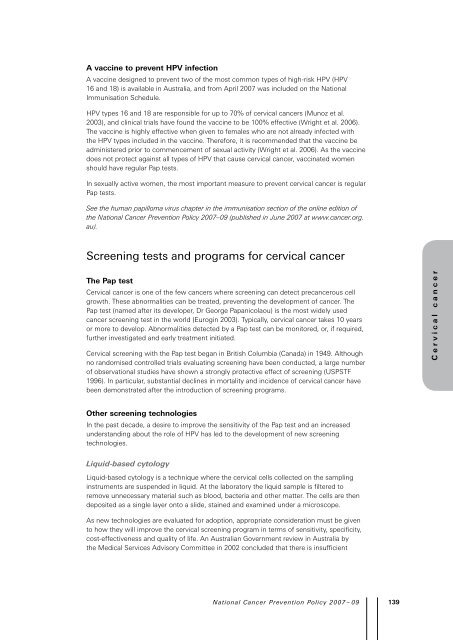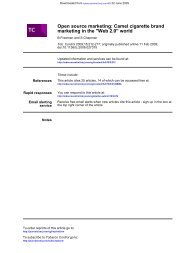National Cancer Prevention Policy - Tobacco Control Supersite
National Cancer Prevention Policy - Tobacco Control Supersite
National Cancer Prevention Policy - Tobacco Control Supersite
Create successful ePaper yourself
Turn your PDF publications into a flip-book with our unique Google optimized e-Paper software.
A vaccine to prevent HPV infection<br />
A vaccine designed to prevent two of the most common types of high-risk HPV (HPV<br />
16 and 18) is available in Australia, and from April 2007 was included on the <strong>National</strong><br />
Immunisation Schedule.<br />
HPV types 16 and 18 are responsible for up to 70% of cervical cancers (Munoz et al.<br />
2003), and clinical trials have found the vaccine to be 100% effective (Wright et al. 2006).<br />
The vaccine is highly effective when given to females who are not already infected with<br />
the HPV types included in the vaccine. Therefore, it is recommended that the vaccine be<br />
administered prior to commencement of sexual activity (Wright et al. 2006). As the vaccine<br />
does not protect against all types of HPV that cause cervical cancer, vaccinated women<br />
should have regular Pap tests.<br />
In sexually active women, the most important measure to prevent cervical cancer is regular<br />
Pap tests.<br />
See the human papilloma virus chapter in the immunisation section of the online edition of<br />
the <strong>National</strong> <strong>Cancer</strong> <strong>Prevention</strong> <strong>Policy</strong> 2007–09 (published in June 2007 at www.cancer.org.<br />
au).<br />
Screening tests and programs for cervical cancer<br />
The Pap test<br />
Cervical cancer is one of the few cancers where screening can detect precancerous cell<br />
growth. These abnormalities can be treated, preventing the development of cancer. The<br />
Pap test (named after its developer, Dr George Papanicolaou) is the most widely used<br />
cancer screening test in the world (Eurogin 2003). Typically, cervical cancer takes 10 years<br />
or more to develop. Abnormalities detected by a Pap test can be monitored, or, if required,<br />
further investigated and early treatment initiated.<br />
Cervical screening with the Pap test began in British Columbia (Canada) in 1949. Although<br />
no randomised controlled trials evaluating screening have been conducted, a large number<br />
of observational studies have shown a strongly protective effect of screening (USPSTF<br />
1996). In particular, substantial declines in mortality and incidence of cervical cancer have<br />
been demonstrated after the introduction of screening programs.<br />
Other screening technologies<br />
In the past decade, a desire to improve the sensitivity of the Pap test and an increased<br />
understanding about the role of HPV has led to the development of new screening<br />
technologies.<br />
Liquid-based cytology<br />
Liquid-based cytology is a technique where the cervical cells collected on the sampling<br />
instruments are suspended in liquid. At the laboratory the liquid sample is filtered to<br />
remove unnecessary material such as blood, bacteria and other matter. The cells are then<br />
deposited as a single layer onto a slide, stained and examined under a microscope.<br />
As new technologies are evaluated for adoption, appropriate consideration must be given<br />
to how they will improve the cervical screening program in terms of sensitivity, specificity,<br />
cost-effectiveness and quality of life. An Australian Government review in Australia by<br />
the Medical Services Advisory Committee in 2002 concluded that there is insufficient<br />
<strong>National</strong> <strong>Cancer</strong> <strong>Prevention</strong> <strong>Policy</strong> 2007 – 09<br />
13<br />
C e r v i c a l c a n c e r




